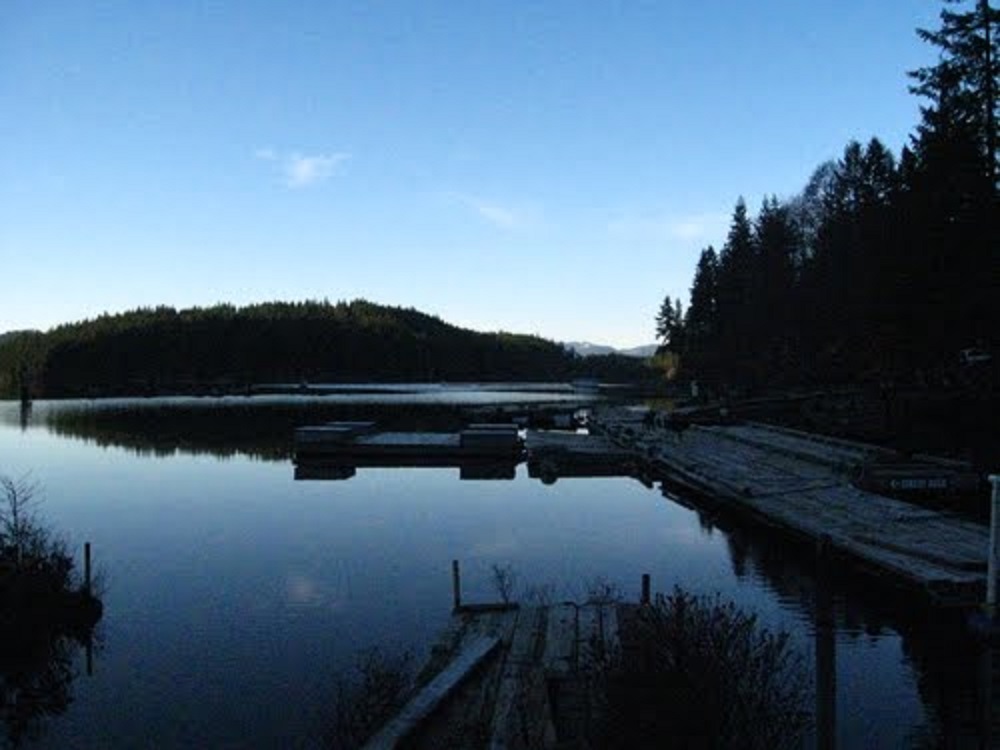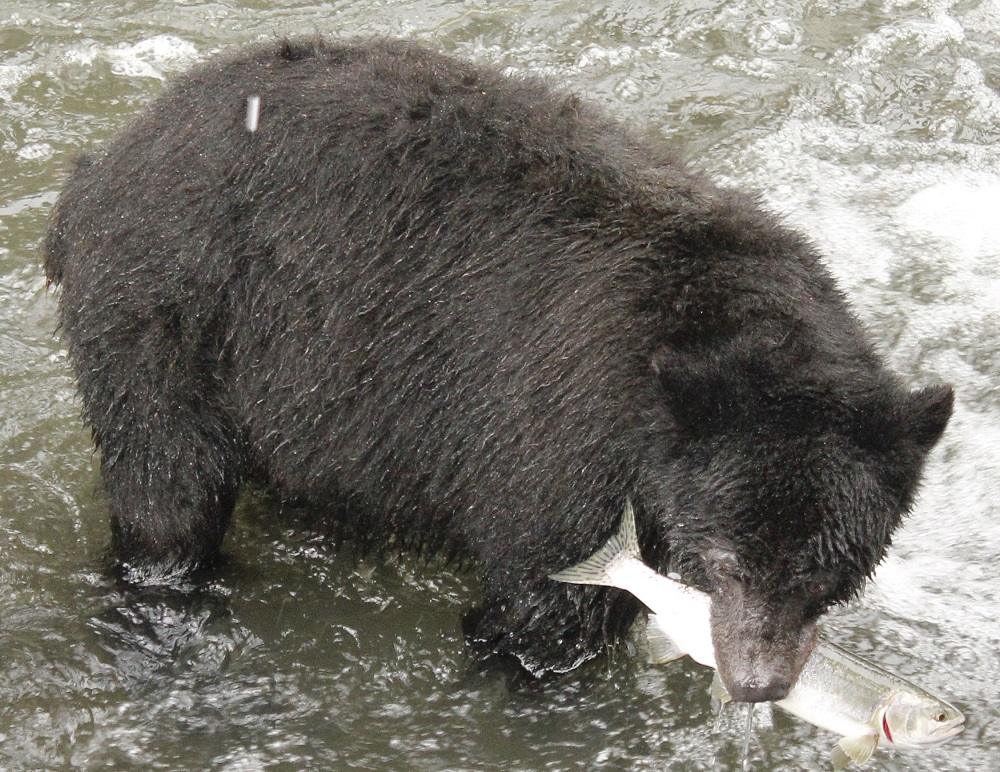For many, many years the Coast Salish lived on the shores of the Campbell River, Vancouver Island area, then for some reason, in the early Campbell River 1800s, they left their villages here and moved to the Comox and Qualicum areas. Then the Kwakiutl First Nations from further north on the Island moved south and occupied the vacated lands left by the Salish.

The Salmon and the Cedar were and are very important to the First Nations people. The sea supplied more than salmon though and the people ate well from it, getting most of their food there.
The Cedar was a tree that was looked upon as a great gift from the transformer, and it supplied them with materials for clothing, ropes, canoes, houses, totem poles and so many other uses including medicine. The abundance of food and other supplies here left time for leisure and this developed into a rich culture full of dances and masks, today the Salmon is still very important to the First Peoples people of the region. The cedar is still a great gift and carvers are still creating masks, canoes, poles, and big houses.

In the early 1500s, Sir Francis Drake arrived just south of Campbell River, Vancouver Island. Then in 1778 Captain James Cook landed in Friendly Cove on Nootka Island and set up trade with the First Peoples of Vancouver Island, followed by Captain George Vancouver who arrived in Campbell River in 1792 and surveyed the area.
In the early 1880s, the first European settlers started to set up shop in the Campbell River area. Charles Thulin, a Campbell River pioneer and founding father of our community arrived at the turn of the century and in 1904, along with his brother, Charles built Campbell Rivers’s first hotel. The first Hotel was built where the Tidemark Theater now stands.
A second hotel was built 2 years later down past St Anne’s Rd. The first hotel was then used to put up loggers and fishermen and the second one was for the more refined clientele, not wanting to mix the two. In 1909, the second hotel burnt down with the loss of 1 life.
It took 2 years, but a third hotel was built on the site of the second hotel. Tragically, in 1963, the third hotel burnt down with the loss of 4 lives. I lived about a block from the hotel in 1963 and was woken up that night by the fire. We watched for hours as they fought it, the Safeway grocery store that was closer to the hotel than our house had damage, and windows were all warped from the heat.

The Thulin’s are still a driving force in our town and own the Home Hardware store, they are involved with many issues and sit on many boards.
As early as 1911 conservation efforts had begun to save areas of Vancouver Island and out of this, Strathcona Provincial Park was created to protect the forests and wildlife of the area. Strathcona Park was British Columbia’s first provincial park, containing over 250,000 hectares, and is to this day Vancouver Island’s largest park.

One of the driving forces behind the creation of the park was James Forbes. He had moved from Victoria to the Lower Campbell Lake area in 1910, In 1911 he met and married Elizabeth Sutherland. James purchased land from the Cudahy Timber Company from their holdings in the area. They settled on this insignificant section of land on the shores of Lower Campbell Lake at the outermost reaches of civilization, alongside a trail that was used by local surveyors and wilderness travellers to access the area that would come to be known as Strathcona Park. Their life in this wilderness area was rough at best with the couple living on a small float house on the lake.
Whenever one of these wilderness travellers required a place to lay their head, the Forbes family was happy to oblige with an offer of the modest comforts of a wood stove and a clean floor.
Soon the couple realized that they were becoming increasingly incapable of accommodating the number of men travelling through their area. So along with the assistance of numerous guests and a few friends, they began the construction of a lodge on the lake.

T
he Lodge was well underway in 1912, built with logs obtained from the International Timber Company. Lumber was brought to the southern shores of Lower Campbell Lake by horse and wagon and from there to the building site by canoe.
Three of Elizabeth’s brothers came to the area in 1912 and helped with the building of the new lodge, after helping in the construction of the lodge, the brothers built and operated a number of tourist cabins on Upper Campbell Lake for many years. The original Forbes Lodge burned down in the forest fire of July 1938 and another was built and opened in the spring of 1939. It was moved to higher ground in 1948 when the level of Lower Campbell Lake was raised about 65 vertical feet by dams built on the river.

In 1972 the Lodge was sold to Jack Slade from Haney BC and then was again destroyed by fire on September 2, 1974, and a well-known historic landmark was forever lost. As a young man, I used to spend time here, there was a great little bar with shuffleboard and darts along with the greatest views of any place in the area.
Today the foundations of the old lodge can still be seen, with some of Elizabeth’s original rose bushes still in place. Forbes Landing is privately owned and maintains itself as a popular destination for camping, trout fishing, and relaxing on the shores of McIvor Lake, surrounded by forest and water on three sides the site has the feeling of an isolated island in the middle of a lakeside oasis.

There are a few homes here and over the years I have had friends and family members live here, allowing me to still enjoy the fishing and views.
The Elk Falls John Hart Hydro Dam was built on the Campbell River system in 1948 and then in 1952 the elk falls pulp and paper mill opened its doors, at one time, it was Campbell River’s largest employer but has recently shut its doors.
Campbell River, Vancouver Island was incorporated as a Village in 1947 and a few years later designated as a Municipal District, Campbell River officially ‘became a City in 2005. For thousands of years, life here has revolved around the Salmon and the Cedar.

Our salmon and the surrounding forests will and have played important roles in our lives. At one time it was commercially by logging and fishing, but now we are migrating towards a tourist-based economy with hiking, biking, camping, fishing, and wildlife viewing of bears, whales, and many other wonders.
We have an Aquarium in the city now, it’s not too big, but it’s really cool. It’s an awesome place to learn about the ocean and what lives in it. I always enjoy visiting the displays and as they are always changing, there’s always something new to see. They will go out and collect various animals from our surrounding waters and have them displayed for a period of time, then they are released back into the area where they were collected.
Campbell River is the hub of the North Island and all that it offers, come on for a visit, our locals are friendly and will make you welcome, the forests around the city are full of trails, and they will lead you on adventures to some pretty amazing sights. The birdlife here is quite varied, and they are such a wonder to observe, our lakes and rivers are beautiful and ready for kayaking, canoeing or just sitting by and enjoying the peace. So grab your hiking pack and trail boots, don’t forget to bring your camera, and get on over here for a visit, you will not regret it.
Elk Falls Park Elk Campground Campbell River Estuary Quinsam River Menzies Bay